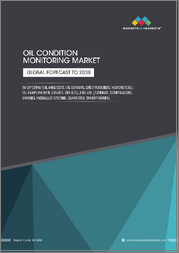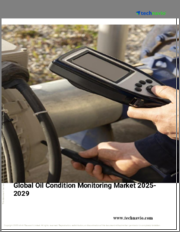
|
시장보고서
상품코드
1733137
세계의 오일 상태 모니터링 시장 조사 보고서 : 산업 분석, 규모, 점유율, 성장, 동향, 예측(2025-2033년)Global Oil Condition Monitoring Market Research Report- Industry Analysis, Size, Share, Growth, Trends and Forecast 2025 to 2033 |
||||||
세계의 오일 상태 모니터링 시장 규모는 2024년 11억 7,000만 달러에서 2033년에는 22억 9,000만 달러로 성장하며, 2026-2033년의 예측 기간 중 7.74%의 견고한 연평균 성장률(CAGR)을 보일 것으로 예측됩니다.
오일 상태 모니터링 시장은 산업계가 사전 예방적 유지보수 및 자산관리의 중요성을 점점 더 인식함에 따라 크게 성장할 준비가 되어 있습니다. 장비 고장 및 계획되지 않은 가동 중단과 관련된 비용이 증가함에 따라 기업은 운영 효율성을 높이고 기계 수명을 연장하기 위해 오일 상태 모니터링 솔루션에 주목하고 있습니다. 이러한 시스템은 첨단 센서와 분석 툴을 사용하여 윤활유 상태를 실시간으로 평가하고 장비의 건전성에 대한 중요한 인사이트를 제공합니다. 제조, 자동차, 항공우주 등의 산업이 계속 발전함에 따라 잠재적인 문제가 심각해지기 전에 감지할 수 있는 고급 오일 상태 모니터링 솔루션에 대한 수요가 시장 확대의 원동력이 될 것으로 보입니다.
또한 지속가능성과 환경적 책임에 대한 관심이 높아지면서 오일 상태 모니터링 시장에도 영향을 미치고 있습니다. 기업이 폐기물을 줄이고 환경에 미치는 영향을 최소화하기 위해 노력하면서 오일 품질을 모니터링하고 윤활유 사용량을 최적화하는 능력이 점점 더 중요해지고 있습니다. 오일 상태 모니터링 시스템을 도입함으로써 기업은 오일 교환 빈도를 줄이고 폐기물을 줄여 자원을 절약할 수 있습니다. 이러한 추세는 장비의 성능을 향상시킬 뿐만 아니라 기업의 지속가능성 목표에 부합하는 모니터링 솔루션의 채택을 촉진할 것으로 예측됩니다. 시장이 발전함에 따라 오일 상태 모니터링 시스템에 IoT와 데이터 분석이 통합되면 그 효율성이 더욱 높아져 조직이 유지보수 작업을 최적화하는 데이터베이스 의사결정을 내릴 수 있게 될 것입니다.
또한 장비 유지보수 및 안전에 대한 규제 모니터링이 강화되면서 오일 상태 모니터링 시장이 형성되고 있습니다. 정부가 직장 안전과 환경 보호를 보장하기 위해 더 엄격한 규제를 시행함에 따라 조직은 이러한 표준을 준수하는 모니터링 솔루션을 채택해야 합니다. 종합적인 보고 및 분석을 제공하는 오일 상태 모니터링 시스템은 조직이 규정 준수를 입증하고 운영의 무결성을 유지할 수 있으므로 높은 수요가 있을 것으로 예측됩니다. 이러한 추세는 시장의 기술 혁신을 촉진하고, 공급업체들은 예측 분석 및 머신러닝 기능을 통합한 고급 솔루션을 개발할 것으로 예측됩니다. 오일 상태 모니터링 시장이 계속 성장함에 따라 신뢰성, 효율성, 지속가능성에 대한 관심은 앞으로도 기술 혁신과 투자를 촉진하는 중요한 요소로 작용할 것입니다.
당사의 보고서는 고객에게 다양한 산업 및 시장에 대한 종합적이고 실용적인 인사이트를 제공하기 위해 세심하게 작성되었습니다. 각 보고서는 시장 상황을 완전히 이해하기 위해 몇 가지 중요한 요소를 포함하고 있습니다.
시장 개요: 정의, 분류, 산업 현황 등 시장에 대한 자세한 소개.
시장 역학: 시장 성장에 영향을 미치는 주요 촉진요인, 억제요인, 기회 및 과제를 자세히 분석합니다. 이 섹션에서는 기술 발전, 규제 변화, 새로운 동향 등의 요인을 검토합니다.
세분화 분석 : 제품 유형, 애플리케이션, 최종사용자, 지역 등의 기준에 따라 시장을 명확한 부문으로 분류합니다. 이 분석을 통해 각 부문의 성과와 잠재력을 파악할 수 있습니다.
경쟁 환경: 시장 점유율, 제품 포트폴리오, 전략적 구상, 재무 실적 등 주요 시장 기업에 대한 종합적인 평가. 주요 기업이 채택하고 있는 경쟁 역학 및 주요 전략에 대한 인사이트을 제공합니다.
시장 예측 : 과거 데이터와 현재 시장 상황을 바탕으로 일정 기간 중 시장 규모와 성장 추세를 예측합니다. 여기에는 정량적 분석과 미래 시장 궤적을 보여주는 그래프 표시가 포함됩니다.
지역 분석 : 지역별 시장 성과를 평가하고 주요 시장 및 지역 동향을 파악할 수 있습니다. 지역 시장 역학 및 비즈니스 기회를 이해하는 데 도움이 됩니다.
새로운 동향과 기회 : 현재 시장 동향과 새로운 시장 동향, 기술 혁신, 잠재적 투자 대상 분야를 파악합니다. 미래 시장 개발 및 성장 전망에 대한 인사이트를 제공합니다.
목차
제1장 서문
제2장 개요
- 시장의 하이라이트
- 세계 시장 스냅숏
제3장 오일 상태 모니터링 - 산업 분석
- 서론 : 시장 역학
- 시장 성장 촉진요인
- 시장 성장 억제요인
- 시장 기회
- 업계 동향
- Porter's Five Forces 분석
- 시장의 매력 분석
제4장 밸류체인 분석
- 밸류체인 분석
- 원재료 분석
- 원재료 리스트
- 원재료 제조업체 리스트
- 주요 원재료의 가격 동향
- 잠재적 바이어 리스트
- 마케팅 채널
- 다이렉트 마케팅
- 인다이렉트 마케팅
- 마케팅 채널 발전 동향
제5장 COVID-19 발생의 영향 분석
제6장 세계의 오일 상태 모니터링 시장 분석 : 제품 유형별
- 개요 : 제품 유형별
- 실적 데이터와 예측 데이터
- 분석 : 제품 유형별
- 터빈 시장 : 지역별
- 컴프레서 시장 : 지역별
- 엔진 시장 : 지역별
- 기어 시스템 시장 : 지역별
- 유압 시스템 시장 : 지역별
제7장 세계의 오일 상태 모니터링 시장 분석 : 샘플링 유형별
- 개요 : 샘플링 유형별
- 실적 데이터와 예측 데이터
- 분석 : 샘플링 유형별
- 온사이트 시장 : 지역별
- 오프사이트 시장 : 지역별
제8장 세계의 오일 상태 모니터링 시장 분석 : 업계별
- 개요 : 업계별
- 실적 데이터와 예측 데이터
- 분석 : 업계별
- 운송 시장 : 지역별
- 석유 및 가스 시장 : 지역별
- 광업 시장 : 지역별
- 에너지·전력 시장 : 지역별
제9장 세계의 오일 상태 모니터링 시장 분석 : 지역별
- 지역별 전망
- 서론
- 북미
- 개요, 실적 데이터, 예측 데이터
- 북미 : 부문별
- 북미 : 국가별
- 미국
- 캐나다
- 멕시코
- 유럽
- 개요, 실적 데이터, 예측 데이터
- 유럽 : 부문별
- 유럽 : 국가별
- 영국
- 프랑스
- 독일
- 이탈리아
- 러시아
- 기타 유럽
- 아시아태평양
- 개요, 실적 데이터, 예측 데이터
- 아시아태평양 : 부문별
- 아시아태평양 : 국가별
- 중국
- 인도
- 일본
- 한국
- 호주
- 기타 아시아태평양
- 라틴아메리카
- 개요, 실적 데이터, 예측 데이터
- 라틴아메리카 : 부문별
- 라틴아메리카 : 국가별
- 브라질
- 아르헨티나
- 페루
- 칠레
- 기타 라틴아메리카
- 중동 아프리카
- 개요, 실적 데이터, 예측 데이터
- 중동 아프리카 : 부문별
- 중동 아프리카 : 국가별 정보
- 사우디아라비아
- 아랍에미리트
- 이스라엘
- 남아프리카공화국
- 기타 중동 및 아프리카
제10장 오일 상태 모니터링 기업의 경쟁 구도
- 오일 상태 모니터링 시장의 경쟁
- 제휴·협력·합의
- 합병·인수
- 신제품 발매
- 기타 개발
제11장 기업 개요
- 기업 점유율 분석
- 시장 집중도
- Honeywell International Inc.
- Micromem Applied Sensor Technologies Inc.
- Parker Hannifin Manufacturing Ltd
- Poseidon Systems, LLC
- Shell
- SPECTRO Analytical Instruments GmbH
- Test Oil(Insight Services Inc.)
- TRIBOMAR GmbH
- Castrol Limited
Global Oil Condition Monitoring Market size is anticipated to grow from USD 1.17 Billion in 2024 to USD 2.29 Billion by 2033, showcasing a robust Compound Annual Growth Rate (CAGR) of 7.74% during the forecast period of 2026 to 2033.
The Oil Condition Monitoring Market is poised for significant growth as industries increasingly recognize the importance of proactive maintenance and asset management. With the rising costs associated with equipment failure and unplanned downtime, organizations are turning to oil condition monitoring solutions to enhance operational efficiency and extend the lifespan of machinery. These systems utilize advanced sensors and analytical tools to assess the condition of lubricants in real-time, providing critical insights into equipment health. As industries such as manufacturing, automotive, and aerospace continue to evolve, the demand for sophisticated oil condition monitoring solutions that can detect potential issues before they escalate will drive market expansion.
Moreover, the growing emphasis on sustainability and environmental responsibility is influencing the oil condition monitoring market. As organizations strive to reduce waste and minimize their environmental impact, the ability to monitor oil quality and optimize lubricant usage becomes increasingly vital. By implementing oil condition monitoring systems, companies can reduce the frequency of oil changes, thereby decreasing waste and conserving resources. This trend is expected to propel the adoption of monitoring solutions that not only enhance equipment performance but also align with corporate sustainability goals. As the market evolves, the integration of IoT and data analytics into oil condition monitoring systems will further enhance their effectiveness, enabling organizations to make data-driven decisions that optimize maintenance practices.
Additionally, the increasing regulatory scrutiny surrounding equipment maintenance and safety is shaping the oil condition monitoring market. As governments implement stricter regulations to ensure workplace safety and environmental protection, organizations are compelled to adopt monitoring solutions that comply with these standards. Oil condition monitoring systems that provide comprehensive reporting and analytics will be highly sought after, as they enable organizations to demonstrate compliance and maintain operational integrity. This trend is expected to drive innovation in the market, with vendors developing advanced solutions that incorporate predictive analytics and machine learning capabilities. As the oil condition monitoring market continues to grow, the focus on reliability, efficiency, and sustainability will remain key drivers of innovation and investment.
Our reports are meticulously crafted to provide clients with comprehensive and actionable insights into various industries and markets. Each report encompasses several critical components to ensure a thorough understanding of the market landscape:
Market Overview: A detailed introduction to the market, including definitions, classifications, and an overview of the industry's current state.
Market Dynamics: In-depth analysis of key drivers, restraints, opportunities, and challenges influencing market growth. This section examines factors such as technological advancements, regulatory changes, and emerging trends.
Segmentation Analysis: Breakdown of the market into distinct segments based on criteria like product type, application, end-user, and geography. This analysis highlights the performance and potential of each segment.
Competitive Landscape: Comprehensive assessment of major market players, including their market share, product portfolio, strategic initiatives, and financial performance. This section provides insights into the competitive dynamics and key strategies adopted by leading companies.
Market Forecast: Projections of market size and growth trends over a specified period, based on historical data and current market conditions. This includes quantitative analyses and graphical representations to illustrate future market trajectories.
Regional Analysis: Evaluation of market performance across different geographical regions, identifying key markets and regional trends. This helps in understanding regional market dynamics and opportunities.
Emerging Trends and Opportunities: Identification of current and emerging market trends, technological innovations, and potential areas for investment. This section offers insights into future market developments and growth prospects.
SEGMENTATION COVERED IN THE REPORT
By Sampling Type
- On-site Sampling
- Off-site Sampling
By Product Type
- Turbine
- Compressor
- Engine
- Gear Systems
- Hydraulic Systems
By End user
- Transportation
- Industrial
- Oil & Gas
- Power Generation
- Mining
- COMPANIES PROFILED
- BP plc
- TotalEnergies
- SGS SA
- Chevron Corporation
- Bureau Veritas
- Intertek Group plc
- Shell plc
- Eaton Corporation
- Parker-Hannifin Corporation
- General Electric
- The above list can be customized.
TABLE OF CONTENTS
1 . PREFACE
- 1.1. Report Description
- 1.1.1. Objective
- 1.1.2. Target Audience
- 1.1.3. Unique Selling Proposition (USP) offerings
- 1.2. Research Scope
- 1.3. Research Methodology
- 1.3.1. Market Research Process
- 1.3.2. Market Research Methodology
2 . EXECUTIVE SUMMARY
- 2.1. Highlights of Market
- 2.2. Global Market Snapshot
3 . OIL CONDITION MONITORING – INDUSTRY ANALYSIS
- 3.1. Introduction - Market Dynamics
- 3.2. Market Drivers
- 3.3. Market Restraints
- 3.4. Opportunities
- 3.5. Industry Trends
- 3.6. Porter's Five Force Analysis
- 3.7. Market Attractiveness Analysis
- 3.7.1 By Product Type
- 3.7.2 By Sampling Type
- 3.7.3 By Industry Vertical
- 3.7.4 By Region
4 . VALUE CHAIN ANALYSIS
- 4.1. Value Chain Analysis
- 4.2. Raw Material Analysis
- 4.2.1. List of Raw Materials
- 4.2.2. Raw Material Manufactures List
- 4.2.3. Price Trend of Key Raw Materials
- 4.3. List of Potential Buyers
- 4.4. Marketing Channel
- 4.4.1. Direct Marketing
- 4.4.2. Indirect Marketing
- 4.4.3. Marketing Channel Development Trend
5 . IMPACT ANALYSIS OF COVID-19 OUTBREAK
6 . GLOBAL OIL CONDITION MONITORING MARKET ANALYSIS BY PRODUCT TYPE
- 6.1 Overview by Product Type
- 6.2 Historical and Forecast Data
- 6.3 Analysis by Product Type
- 6.4 Turbines Market by Regions
- 6.5 Compressors Market by Regions
- 6.6 Engines Market by Regions
- 6.7 Gear Systems Market by Regions
- 6.8 Hydraulic Systems Market by Regions
7 . GLOBAL OIL CONDITION MONITORING MARKET ANALYSIS BY SAMPLING TYPE
- 7.1 Overview by Sampling Type
- 7.2 Historical and Forecast Data
- 7.3 Analysis by Sampling Type
- 7.4 On-site Market by Regions
- 7.5 Off-site Market by Regions
8 . GLOBAL OIL CONDITION MONITORING MARKET ANALYSIS BY INDUSTRY VERTICAL
- 8.1 Overview by Industry Vertical
- 8.2 Historical and Forecast Data
- 8.3 Analysis by Industry Vertical
- 8.4 Transportation Market by Regions
- 8.5 Oil and Gas Market by Regions
- 8.6 Mining Market by Regions
- 8.7 Energy and Power Market by Regions
9 . GLOBAL OIL CONDITION MONITORING MARKET ANALYSIS BY GEOGRAPHY
- 9.1. Regional Outlook
- 9.2. Introduction
- 9.3. North America
- 9.3.1. Overview, Historic and Forecast Data
- 9.3.2. North America By Segment
- 9.3.3. North America By Country
- 9.3.4. United State
- 9.3.5. Canada
- 9.3.6. Mexico
- 9.4. Europe
- 9.4.1. Overview, Historic and Forecast Data
- 9.4.2. Europe by Segment
- 9.4.3. Europe by Country
- 9.4.4. United Kingdom
- 9.4.5. France
- 9.4.6. Germany
- 9.4.7. Italy
- 9.4.8. Russia
- 9.4.9. Rest Of Europe
- 9.5. Asia Pacific
- 9.5.1. Overview, Historic and Forecast Data
- 9.5.2. Asia Pacific by Segment
- 9.5.3. Asia Pacific by Country
- 9.5.4. China
- 9.5.5. India
- 9.5.6. Japan
- 9.5.7. South Korea
- 9.5.8. Australia
- 9.5.9. Rest Of Asia Pacific
- 9.6. Latin America
- 9.6.1. Overview, Historic and Forecast Data
- 9.6.2. Latin America by Segment
- 9.6.3. Latin America by Country
- 9.6.4. Brazil
- 9.6.5. Argentina
- 9.6.6. Peru
- 9.6.7. Chile
- 9.6.8. Rest of Latin America
- 9.7. Middle East Africa
- 9.7.1. Overview, Historic and Forecast Data
- 9.7.2. Middle East Africa by Segment
- 9.7.3. Middle East Africa by Country
- 9.7.4. Saudi Arabia
- 9.7.5. UAE
- 9.7.6. Israel
- 9.7.7. South Africa
- 9.7.8. Rest Of Middle East And Africa
10 . COMPETITIVE LANDSCAPE OF THE OIL CONDITION MONITORING COMPANIES
- 10.1. Oil Condition Monitoring Market Competition
- 10.2. Partnership/Collaboration/Agreement
- 10.3. Merger And Acquisitions
- 10.4. New Product Launch
- 10.5. Other Developments
11 . COMPANY PROFILES OF OIL CONDITION MONITORING INDUSTRY
- 11.1. Company Share Analysis
- 11.2. Market Concentration Rate
- 11.3. Honeywell International Inc.
- 11.3.1. Company Overview
- 11.3.2. Financials
- 11.3.3. Products
- 11.3.4. Recent Developments
- 11.4. Micromem Applied Sensor Technologies Inc.
- 11.4.1. Company Overview
- 11.4.2. Financials
- 11.4.3. Products
- 11.4.4. Recent Developments
- 11.5. Parker Hannifin Manufacturing Ltd
- 11.5.1. Company Overview
- 11.5.2. Financials
- 11.5.3. Products
- 11.5.4. Recent Developments
- 11.6. Poseidon Systems, LLC
- 11.6.1. Company Overview
- 11.6.2. Financials
- 11.6.3. Products
- 11.6.4. Recent Developments
- 11.7. Shell
- 11.7.1. Company Overview
- 11.7.2. Financials
- 11.7.3. Products
- 11.7.4. Recent Developments
- 11.8. SPECTRO Analytical Instruments GmbH
- 11.8.1. Company Overview
- 11.8.2. Financials
- 11.8.3. Products
- 11.8.4. Recent Developments
- 11.9. Test Oil (Insight Services Inc.)
- 11.9.1. Company Overview
- 11.9.2. Financials
- 11.9.3. Products
- 11.9.4. Recent Developments
- 11.10. TRIBOMAR GmbH
- 11.10.1. Company Overview
- 11.10.2. Financials
- 11.10.3. Products
- 11.10.4. Recent Developments
- 11.11. Castrol Limited
- 11.11.1. Company Overview
- 11.11.2. Financials
- 11.11.3. Products
- 11.11.4. Recent Developments




















